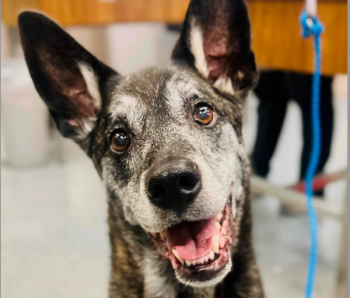
Extending quality of life for cancer patients
Q: Please provide a review on palliative care for animals diagnosed with cancer.
Q: Please provide a review on pallia-tive care for animals diagnosed with cancer.
A: Dr. Dennis Bailey gave an excellent lecture on Palliative Care for Cancer Patients at the 2008 American College of Veterinary Internal Medicine Forum in San Antonio. Here are some relevant points:
Neoplasia still remains one of the most common causes of death and euthanasia in dogs and cats. For seve-ral common forms of cancer, such as lymphoma and osteosarcoma, aggressive treatment consistently provides extended periods of excellent quality of life but only rarely provides a cure.
Many dogs and cats diagnosed with cancer never undergo definitive cancer therapy, either because they are not good candidates or because of owner choice. For these animals, palliative care is important to provide and sustain an excellent quality of life for as long as possible.
It is important to recognize that a treatment is defined as palliative care or definitive therapy based on the intended outcome, not the actual outcome.
Palliative care refers to supportive care given to improve or maintain quality of life, without necessarily slowing the progression of the cancer or prolonging life. In contrast, definitive therapy refers to aggressive treatment administered with the goal of trying to slow cancer progression and prolong life.
Palliative care should not be regarded as "giving up." Some dogs and cats with advanced-stage cancers do not benefit from more aggressive definitive-intent therapy. For example, when dogs with metastatic osteosarcoma are treated with definitive-intent therapy, survival times are compar-able to those achieved with palliative care alone. Conversely, palliative care should not be regarded as "enabling the owner to prolong the inevitable." If an animal's quality of life is suboptimal and cannot be restored with palliative care, then humane euthanasia should be recom-mended. However, palliative care often is very effective at restoring quality of life or prolonging excellent quality of life. Additionally, whenever palliative care is being provided, close owner communication is essential to ensure that quality of life is being maintained.
Nutritional support
Malnutrition is a common complication of cancer. A recent veterinary study indicated that, while only 4 percent of dogs with cancer were emaciated — defined as body conditioning score <3 out of 9 — at the time of initial diagnosis, 68 percent had documented evidence of weight loss and 15 percent had moderate to severe muscle wasting. Cancer cachexia is a complex metabolic syndrome characterized by weight loss, anorexia and wasting of lean body mass secondary to the growing malignancy.
The factors contributing to cancer cachexia can be divided into two broad categories. The first includes mechanical and functional abnormalities that lead to decreased nutrient intake.
Oral tumors can cause dysphagia and considerable pain. Gastrointestinal tumors can cause pain, early satiety, mechanical obstruction, nausea, vomiting, diarrhea and malabsorption of nutrients. Advanced-stage neoplasia, regardless of its anatomic location, often is associated with partial or complete anorexia.
The second group of factors includes numerous metabolic derangements that prevent the body from efficiently using nutrients. Abnormalities in the way the body uses carbohydrates, proteins and lipids all have been identified. The result is that a cancer patient can lose weight and lean muscle mass even in the face of adequate food intake. The underlying mechanisms for these metabolic derangements are not completely understood, but substances released by the tumor itself and by the patient's body in response to the tumor are both thought to play important roles.
An animal's nutritional assessment is based on a thorough history and physical examination. It is important to ask an owner about his or her animal's usual dietary habits, including the type of food, the amount fed at each meal, the number of meals per day, the types and amounts of treats given and the extent of the animal's appetite.
The owner should then be asked about any recent changes in dietary habits, as well as any changes in body weight or body conditioning. Physical examination should then be used to assess weight, body condition and muscle mass objectively. If available in the medical record, previous assessments should be used as a baseline for comparison.
Early changes associated with cancer cachexia may be as subtle as the animal not finishing its food as quickly as usual or requiring some coaxing. As cancer cachexia progresses, the animal's nutritional intake will become inadequate despite coaxing and offering more palatable foods, and eventually weight loss and muscle wasting will become evident.
How aggressively to provide nutritional support depends on the severity of the animal's nutritional deficiencies. Minimal deficiencies can be overcome by offering palatable foods such as commercial nutritional support diet or boiled chicken and rice. The latter is not nutritionally balanced, and additional supplements are needed if this diet is going to be used long-term.
For moderate anorexia, appetite stimulants such as prednisone, cyproheptadine and mirtazapine can be used. If food intake is thought to be reduced because of nausea, gastroprotectants such as famotidine and sucralfate may be considered. Anti-emetics such as metoclopramide, dolasetron, ondansetron and maropitant are indicated to help control nausea and vomiting.
If voluntary food intake cannot be restored or maintained, then supplemental feeding is needed. Whenever possible, it is preferable to use the GI tract. This way, the nutrients provided are digested and metabolized through normal pathways.
In addition, food within the intestine plays a critical role in maintaining gut health and function. The most commonly used feeding tubes are esophagostomy tubes and gastrostomy tubes. Both can be left in place indefinitely. The main advantage of an esophagostomy tube is the ease of placement — they can be placed quickly and easily under light general anesthesia without any specialized equipment. In contrast, gastrostomy tube placement usually is done surgically or with endoscopic guidance.
The main advantage of a gastrostomy tube is that it is wider in diameter and can accommodate a wider variety of foods. Additionally, low-profile gastrostomy tubes can be used to eliminate the need for cumbersome and potentially uncomfortable bandages.
There is ongoing discussion about so-called "cancer diets." Their general features include low quantities of simple carbohydrates, moderate quantities of highly digestible proteins rich in arginine and glutamine and relatively high quantities of lipids and omega-3-fatty acids.
However, the use of such diets has been evaluated primarily in dogs with lymphoma. It is more important for an animal's diet to be palatable and nutritionally balanced. Changing an animal's diet to a cancer diet should be considered only if caloric and general nutritional requirements are being maintained without any difficulty.
Get the animal to eat first; worry about what it is eating second.
Pain management
Cancer pain is one of the most important factors affecting overall quality of life. In human oncology, it is estimated that cancer pain is experienced by 30 percent to 50 percent of people undergoing active cancer treatment and 70 percent to 90 percent of people with advanced disease. It is difficult to accurately assess the prevalence of pain in veterinary cancer patients, but it is reasonable to assume that it is comparable to that.
Cancer pain likely is underappreciated in veterinary cancer patients because it is relatively difficult to assess objectively. Physiologic variables such as heart rate, respiratory rate and pupil size are not reliable indicators of pain. Instead, pain assessment is based primarily on behavior. Subtle changes in activity level, attitude, appetite or grooming can be early signs of pain. As pain becomes more severe, aversion to petting/palpation may be noticed. Vocalization usually is seen only when pain is severe.
Because the owner sees the dog or cat every day in its own environment, he or she is best able to assess behavior changes. Therefore, it is crucial to educate the owner about what signs to look for, to ask the owner for feedback on a regular basis and to trust the information provided by the owner.
It is very important always to be aware of the potential for cancer pain and to take a proactive approach with respect to its diagnosis and treatment. Pain can be prevented far more easily than it can be reversed. Chronic pain induces physical changes in the spinal cord that alter the way pain signals are processed, resulting in hyperalgesia and allodynia. These changes decrease the efficacy of analgesic medications, making it much more difficult to alleviate an animal's pain. Additionally, even if the pain eventually is controlled, the physical changes in the spinal cord are not necessarily fully reversible.
Dog and cat owners do not want their beloved pet to be in pain. Do something about it.
Pain management typically is most effective when multiple treatment modalities are used in combination. When animals present with mild pain, non-opioid analgesics such as nonsteroidal anti-inflammatory drugs (carprofen, deracoxib, meloxicam) may be attempted first. For moderate pain, a weak opioid such as codeine, buprenorphine or tramadol can be added.
For severe pain, strong opioids such as morphine or fentanyl are indicated. While veterinary analgesia involves primarily the use of nonsteroidal anti-inflammatory drugs and opioids, the adjunct use of additional drugs such as gabapentin and amantadine is gaining popularity.
In addition to using analgesics, several other treatment modalities should be considered and used whenever appropriate. Local anesthetic nerve blocks are very useful for orofacial tumors and for phantom pain associated with amputation. Using a mixture of bupivacaine, lidocaine, methylprednisolone and serapin can be a good locoregional pain control enduring for up to one month per injection.
Bisphosphonates are drugs that prevent bone resorption by inhibiting the formation of new osteoclasts, inhibiting the ability of mature osteoclasts to resorb bone, and inducing osteoclast apoptosis.
By inhibiting tumor-associated osteolysis, bisphosphonates can help reduce the pain associated with both primary and metastatic bone tumors. Pamidronate currently is the bisphosphonate used most commonly in veterinary medicine. A dosage of 1.0-2.0 mg/kg every four weeks has been reported. To minimize the risk of renal toxicity, the pamidronate dose should be diluted in 250 ml 0.9 percent NaCl and then administered intravenously over two hours.
In one study, 12 out of 43 dogs (28 percent) with appendicular osteosarcoma experienced clinically significant pain relief that persisted more than four months. There is anecdotal evidence that the oral bisphosphonate alendronate may be beneficial for dogs with osteosarcoma, but its routine use is not recommended because of poor absorption from the gastrointestinal tract.
Palliative radiation therapy
Palliative radiation therapy proto-cols are delivered with the intent of alleviating pain or another side effect associated with an incurable tumor. Palliative radiation therapy typically is reserved for animals with a decreased quality of life and that likely would not benefit from a more aggressive definitive course of radiation treatment.
Radiation therapy protocols are defined as definitive or palliative based on the total radiation dose and fractionation scheme. Definitive protocols typically involve the delivery of 2.25 to 3.20 Gy per fraction on a Monday-through-Friday basis for a total of 16 to 25 treatments and a total dose of 48 to 63 Gy.
Palliative radiation protocols typically involve the administration of a larger dose per fraction, but a fewer total number of fractions and lower total radiation dose. A variety of palliative protocols exist. One of the most commonly used protocols is 8 Gy per fraction, given once weekly for four consecutive weeks for a total dose of 32 Gy. Another involves 5 Gy per fraction once daily for five consecutive days for a total dose of 25 Gy.
Palliative protocols typically are associated with minimal to no acute adverse effects, such as moist desquamation of the skin or oral mucositis. The larger dose per fraction does increase the risk for late adverse effects, but most animals receiving palliative radiation therapy typically do not live long enough to develop late effects.
Palliative radiation therapy has been studied most thoroughly for the treatment of canine osteosarcoma. Approximately 75 percent to 90 percent of dogs experience pain relief based on an improvement in lameness. The median time from when radiation therapy is initiated to when lameness improves is around 14 days (range, one to 60 days). Median duration of analgesia is around two to four months, but individuals have enjoyed considerably longer periods of pain relief. Palliative radiation therapy also has been effectively used to treat oral tumors, nasal tumors, thyroid carcinomas and soft-tissue sarcomas.
Prednisone
Prednisone can be used as a chemo-therapy drug for some forms of cancer. When dogs with lymphoma are treated with single-agent prednisone, approximately half will attain either a partial or complete remission. Remissions usually are transient, though, and survival times typically are around one to two months. Prednisone can be used for cats with lymphoma; survival times usually are less than one month. Canine mast-cell tumors can be treated palliatively with single-agent prednisone. Approximately 20 percent of dogs will enjoy a partial or complete remission. Response durations are variable, but usually persist for a few weeks to a few months.
It is critical to reach a definitive diagnosis of cancer before placing an animal on a palliative course of steroids.
While response rates to prednisone are low, the responses that do occur can be quite dramatic, particularly for dogs with lymphoma. It is not uncommon for an owner to change his or her mind and request that more aggressive therapy be initiated after seeing a marked response to prednisone.
However, reaching a definitive diagnosis once the animal is in a partial or complete remission can be difficult or impossible, and it is below current standards of care to initiate aggressive cytotoxic chemotherapy without a definitive diagnosis of cancer.
Additionally, before starting a course of palliative steroids, owners always should be counseled that if they decide to pursue more aggressive chemotherapy at a future time, pretreatment with steroids can induce multi-drug resistance mechanisms that diminish the efficacy of chemotherapy.
The anti-inflammatory effects of prednisone can be very beneficial as well. Tumors often can induce an inflammatory response, and this secondary peritumoral inflammation and edema can have a significant clinical impact. For example, in dogs and cats with brain tumors, an anti-inflammatory course of prednisone can dramatically improve clinical signs for up to a few months. Prednisone can reduce the congestion and stertorous breathing often seen in animals with nasal tumors, as well as the coughing associated with pulmonary metastasis. Prednisone also can help maintain quality of life by improving appetite and energy level.
Psychological support
Palliative care is about quality of life. Alleviate anything that is hindering quality of life, and try to prevent future hindrances from arising. There is no single best palliative treatment plan. The plan chosen will depend on the tumor type, the tumor location, the patient's clinical signs and the owner's goals.
Because there are so many variables, close communication between the veterinary staff and the owner is vital. The owner sees his or her animal in its own environment every day and therefore will recognize subtle changes more quickly. This feedback can be used by the veterinary staff to modify the palliative treatment as needed.
At the same time, this feedback will help strengthen the bond between the owner and veterinarian, a bond that becomes even more important when quality of life can no longer be maintained and the conversation turns to euthanasia. The strong trust that has been fostered will allow the owner to realize that you have his or her animal's best interest at heart and take comfort in the knowledge that everything was done to provide his or her family member with the best possible quality of life for as long as possible.
Dr. Hoskins is owner of Docu-Tech Services. He is a diplomate of the American College of Veterinary Internal Medicine with specialities in small animal pediatrics. He can be reached at (225) 955-3252, fax: (214) 242-2200 or e-mail:
Newsletter
From exam room tips to practice management insights, get trusted veterinary news delivered straight to your inbox—subscribe to dvm360.






